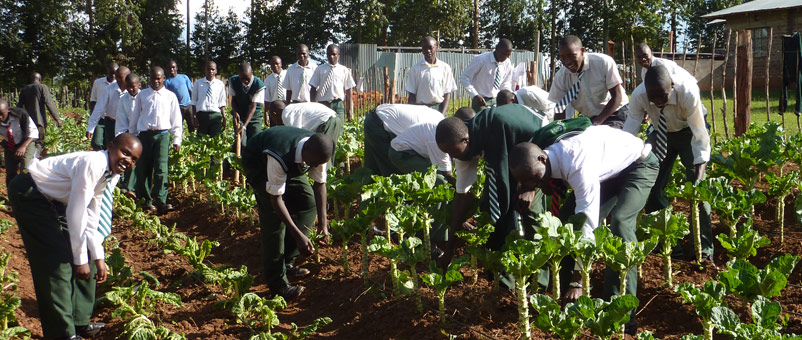When the UN announced its Decade of Action on Nutrition in 2016, hot on the heels of the Sustainable Development Goals, many media outlets used a picture of a child eating a bowl of white rice, to illustrate the promise of better nutrition for all.
There’s just one problem. Rice alone is not enough. Yes, it will prevent the most basic form of hunger but rice lacks many of the vitamins and minerals essential for good health.

Credit: Wagner T. Cassimiro
Without these vitamins and minerals, this child’s growth will be stunted, his immune system weakened, and his intelligence lower than it ought to be, costing him a lifetime of lost income and productivity. That is why the Sustainable Development Goal’s Target 2.1 of “access to safe, nutritious and sufficient food all year round” is so important, because it adds “nutritious” to “sufficient”.
I don’t want to downplay the importance of “sufficient”; we face a great challenge in ensuring enough food for everyone in the face of both climate change and population growth – a challenge that Bioversity International and agricultural biodiversity are helping to meet. For now, though, let’s concentrate on “nutritious” food.
The most important factor in a nutritious diet is diversity. That concept is enshrined in national dietary guidelines around the world, with their advice to eat fruits and vegetables, whole grains, pulses and so on. Research conducted by Bioversity International in collaboration with the Earth Institute shows that increasing food supply diversity is associated with lower levels of acute and chronic child malnutrition (stunting, wasting and underweight) at a national level. Agricultural policies and funding for research, however, generally focus on the four or five commodity staples that supply the bulk of calories. From the 5,538 known plant species, just three – rice, wheat and maize – provide more than 50% of the world’s plant-derived calories.

And although people may be aware that they should make healthier choices, the food system that surrounds them – which is the product of both food industry and government policy – often makes it difficult to choose a more diverse and more nutritious diet.
Nutritious staples
One successful approach is to diversify staples – mainstay foods – in the diet to include more nutritious alternatives.
For example, bananas are the fourth most important food crop in Africa, which is also home to high levels of vitamin A deficiency, a major public health problem in many developing countries. Every year, a half a million children go blind from the lack of vitamin A, and half of those die from infections.

Orange-fleshed Fe’i bananas from the Pacific. Credit: Bioversity International
‘Mining’ banana diversity to find varieties with a higher content of vitamin A could be part of the solution. It is estimated that there are over 1,000 varieties of bananas in the world, which range from green to pale yellow to orange to dark red. The genetic diversity in these varieties determines not just these differences you can see and taste, they also determine micronutrient levels. For example, the orange-fleshed. Karat banana contains 1,000 times more of the pigment which the human body can convert into vitamin A (carotenoids) than the Cavendish banana, which is the variety of bananas most Western consumers see in their supermarkets.
Bioversity International is conducting research with partners in Burundi and the Democratic Republic of Congo (DRC) to see how using this banana diversity can help increase the levels of vitamin A in diets.
In India, we are also working to bring different kinds of nutritious and resilient millets, which were once part of traditional diets, back to plates and markets. While widespread famine in India is a thing of the past, malnutrition is not. India has high levels of stunting in young children and, by contrast, equally high levels of overweight, obesity and illnesses such as heart disease and diabetes.

Children in Kolli Hills enjoy eating millets. Credit: Bioversity International/ G. Meldrum
Foxtail millet, for example, contains almost twice the protein of white rice, and little millet almost nine times the iron. In just three months of replacing white rice with millets in school meals, children gained weight and had improved haemoglobin levels.
Results such as these, and many more from Bioversity International’s work on neglected and underutilized species, helped prompt the national and state authorities in India to amend their food legislation. Millets are now included in some state school feeding programmes and have been incorporated in the national public distribution system. This is obviously a good thing for the poorer and nutritionally vulnerable people who receive subsidised food, and it also benefits the farmers who grow millet, which is much less ecologically demanding than other staples. Nutrition, local economies, the environment and food security: all thus gain from expanding the diversity of diet.
We can do it
There is no single solution to combat malnutrition, but using more diverse crops and varieties in our fields and on our plates must be part of the solution.
To make this a reality, we need to take action at multiple levels. Consumers can influence production by choosing nutritious, fresh, local and diverse foods. Agricultural research should increase knowledge on the use of agrobiodiversity to make farming systems more nutritious, resilient and sustainable. Governments can make the difference by creating food and agricultural policies that promote and integrate agrobiodiversity as an essential tool to achieve multiple Sustainable Development Goals.
Use #SDG2countdown to search for more content and share your own biodiversity stories on Twitter, or visit farmingfirst.org/sdgs for more!
Featured photo credit: Bioversity International/A. Drucker



